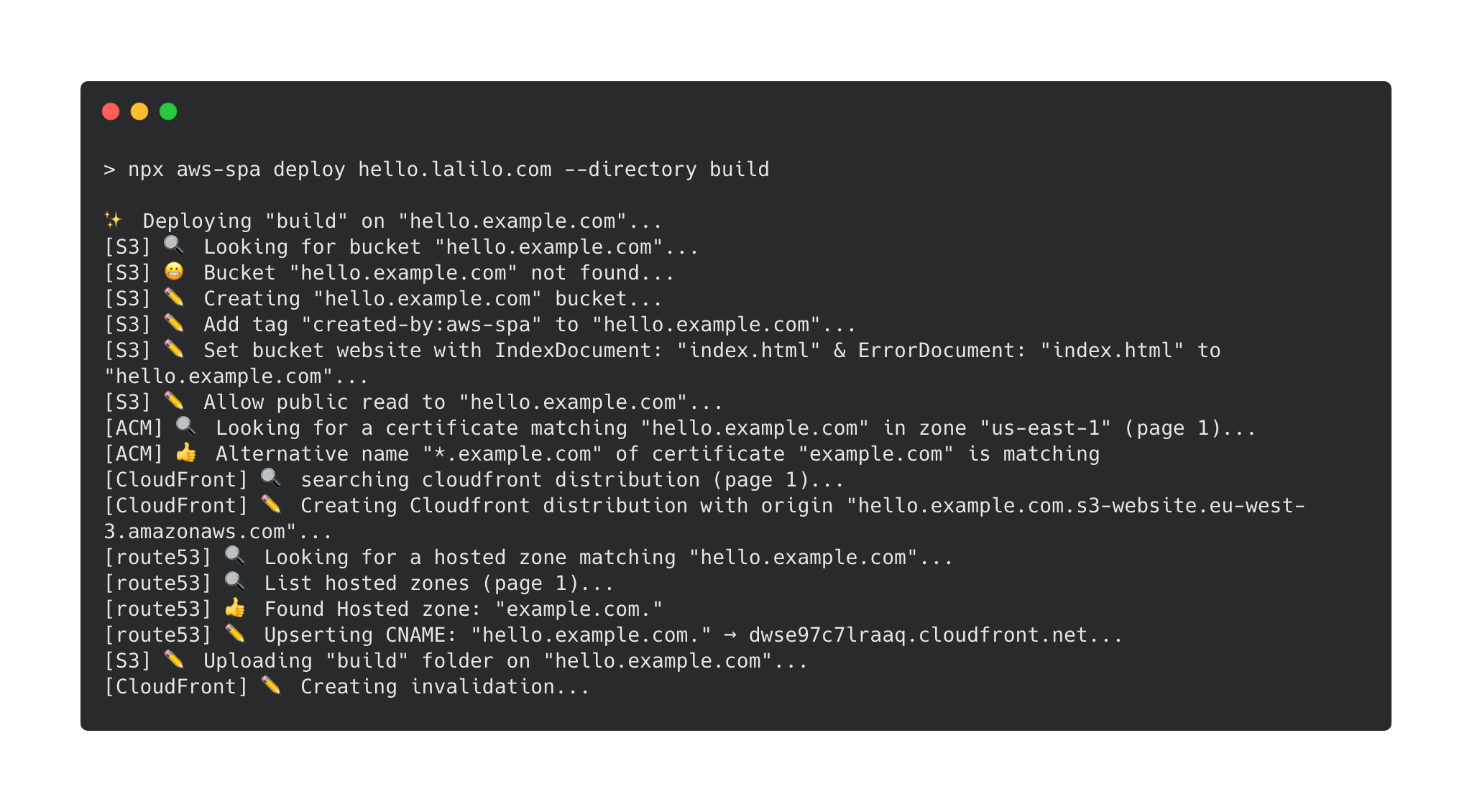aws-spa
v5.1.0
Published
A no-brainer script to deploy a single page app on AWS
Readme
aws-spa
Deploy a single page app on AWS in one command.
Note: this repository is intended for internal use at Lalilo, and supports only our current deployment needs. We recommend against using it as-is in your production apps as our updates may contain breaking changes and won't be maintained to support other use cases.

Install & use
npm install --dev aws-spa
npx aws-spa deploy --helpWhy?
Configuring the deployment of a single page app is harder than it should be. Most SPA configuration are very similar. aws-spa embodies this idea. It is meant to handle all the quirks associated with SPA configuration.
Features
- Create AWS Bucket & CloudFront distribution & Route 53 record & ACM certificate and configure it
- Serve gzipped file
- Invalidate CloudFront after deployment
- idempotent script
Get Started
With create-react-app
npx create-react-app hello-world && cd hello-world
yarn add aws-spa
yarn build
# read about [create-react-app static file caching](https://facebook.github.io/create-react-app/docs/production-build#static-file-cachin)
npx aws-spa deploy hello.example.com --cacheInvalidation "index.html" --cacheBustedPrefix "static/"API
aws-spa deploy
Deploy a single page app on AWS
Positionals
domainName:
The domain name on which the SPA will be accessible. For example app.example.com.
You can also specify a path: app.example.com/something. This can be useful to deploy multiple versions of an app in the same s3 bucket. For example one could deploy a feature branch of the SPA like this:
aws-spa deploy app.example.com/$(git branch | grep * | cut -d ' ' -f2)Options
--wait: Wait for CloudFront distribution to be deployed & cache invalidation to be completed. If you choose not to wait (default), you won't see site changes as soon as the command ends.--directory: The directory where the static files have been generated. It must contain an index.html. Default isbuild.--cacheInvalidation: cache invalidation to be done in CloudFront. Default is*: all files are invalidated. For acreate-react-appapp you only need to invalidate/index.html--cacheBustedPrefix: a folder where files are suffixed with a hash (cash busting). Theircache-controlvalue is set tomax-age=31536000. For acreate-react-appapp you can specifystatic/.--noPrompt: Disable confirm message that prompts on non CI environments (env CI=true).--shouldBlockBucketPublicAccess: This option will deploy the SPA with a bucket not being publicly accessible. Access to the bucket will be done through an Origin Access Control (OAC). Default value is false.--noDefaultRootobject: Instead of using index.html as the root object, allows to resolve example.com/ to example.com//index.html using a cloudfront function.--redirect403ToRoot: Redirect 403 errors to the root of the SPA. This is useful if you want to use client-side routing with an S3 static website without using a hash router.--objectExpirationDays: Add a lifecycle configuration to the bucket that clean object after a number of days. This avoid having numerous outdated branch in the bucket.--viewerRequestFunctionNames: Add existing CloudFront functions as viewer-request function. Specified functions must already exist or the command will fail. If a lamdba function is already associated, the command will also fail (existing CloudFront functions will be replaced)--viewerResponseFunctionNames: Add existing CloudFront functions as viewer-response function. Specified functions must already exist or the command will fail. If a lamdba function is already associated, the command will also fail (existing CloudFront functions will be replaced)--additionalDomainNames: Specify additional domain names to assign to the CloudFront definition (in addition to the domain name).
Migrate an existing SPA on aws-spa
aws-spa is aware of the resources it is managing thanks to tags.
If a S3 bucket named with the domain name already exists, a prompt will ask you if you want to deleguate the management of this bucket to aws-s3 (this will basically checks that s3 bucket is well configured to serve a static website).
If a CloudFront distribution with this S3 bucket already exists, the script will fail because CloudFront distribution update is quite complicated.
- If you don't care about downtime, you can delete the CloudFront distribution first.
- If you care about downtime, you can configure the CloudFront distribution by yourself (don't forget to gzip the files) and then add the tag key:
managed-by-aws-spa, value:v1.
IAM
cloudfront:CreateDistribution
cloudfront:ListDistributions
cloudfront:ListTagsForResource
cloudfront:TagResource
cloudfront:GetDistributionConfig
cloudfront:CreateInvalidation
cloudfront:UpdateDistribution
cloudfront:ListOriginAccessControls
cloudfront:GetOriginAccessControl
cloudfront:CreateOriginAccessControl
cloudfront:DeleteOriginAccessControl
s3:PutBucketPolicy
s3:GetBucketPolicy
s3:PutBucketWebsite
s3:GetBucketWebsite
s3:DeleteBucketWebsite
s3:PutBucketTagging
s3:GetBucketTagging
s3:DeleteBucketTagging
s3:ListBucket
s3:PutBucketPublicAccessBlock
s3:CreateBucket
s3:PutObject
s3:PutLifecycleConfiguration
s3:GetLifecycleConfiguration
route53:ListHostedZones
route53:CreateHostedZone
route53:ListResourceRecordSets
route53:ChangeResourceRecordSets
acm:ListCertificates
acm:DescribeCertificate
acm:RequestCertificate
lambda:CreateFunction
lambda:GetFunctionConfiguration
lambda:UpdateFunctionCode
lambda:UpdateFunctionConfiguration
iam:AttachRolePolicy
iam:CreateRole
iam:GetRole
If using simple auth
- lambda:GetFunction
- lambda:EnableReplication*
- iam:CreateServiceLinkedRole
- iam:CreateRole on resource: arn:aws:iam::<account_id>:role/aws-spa-basic-auth-*
FAQ
Why not using Ansible, Saltstack, Terraform, Cloudformation, Troposphere, etc?
If it better suits your use case, these tools are probably a very good choice because there are done for this. Meanwhile there are some reasons why it is written in javascript:
- in my CI/CD installing Ansible, awscli or Terraform takes more than 1 minute. Since my SPA needs nodejs to be built, having a the same dependency to deploy is convenient & fast.
- Developers would have to learn these tools while they have already tons of things to learn. Using a script in the same language that they develop is nice.
- These tools are quite heavy while deploying a SPA requires only a couple of AWS API calls.
